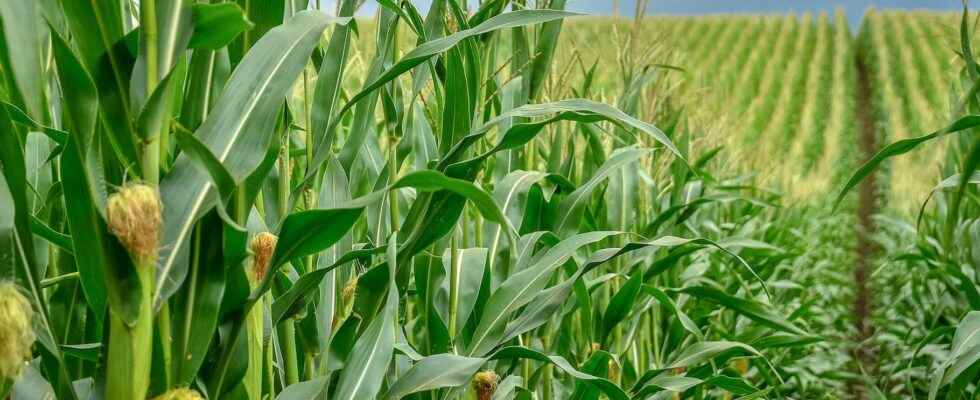By upsetting the balance between the various meteorological parameters, in particular temperatures and precipitation, climate change will have a major impact on agricultural production in the coming decades. To estimate the evolution of cereal production throughout the world, the NASA science visualization studio used a climate projection model, the CMIP6 (Climate Model Intercomparison Project-Phase 6) and an agricultural projection model, agMIP (Agricultural Model Intercomparison Project).
According to the forecasts ofemissions greenhouse gases and long term climate forecastbut also by taking into account the current distribution and the needs of several varieties of cereals, the models made it possible to draw up a map of the evolution of cereal fields throughout the world until 2100.
Corn will be halved by 2100
The researchers selected two types of cereals widespread throughout the world and very affected by global warming. At the global level, it is the But who will be most affected by the weather, with forecasts that envisage an average drop of 24% in its global production. Taking into account the same climate projections, the wheat should undergo a radically different evolution: wheat fields could increase by 17% in the world by the end of the century.
With regard to the evolution of cornfield, North America, the world’s leading maize producer (40% of world production) should be the most affected area. According to the projections of the Nasathe entire eastern half of the United States and all of Mexico are expected to see their cornfields collapse by 30-40% by 2100. As well as Colombia, Venezuela, parts of Brazil, Bolivia and Paraguay.
The trend will also be downward for India, China, Thailand, Laos, Malaysia, Indonesia and the Philippines. In Europe, 5and corn producer in the world, the area occupied by corn fields should drop by 20 to 40% in the eastern half of France, Spain, Italy, Eastern Europe, but also over a large western and southern half of Africa (Mauritania, Nigeria, Ivory Coast, Congo…).
However, there are a few very rare areas where maize production should increase by the end of the century, such as eastern Brazil (up to 40% more), a small corner of East Africa (Kenya , Uganda), but also Switzerland, Austria and Turkey.
Wheat will make great progress in the Northern Hemisphere
I’evolution of wheat plots is on the rise almost everywhere: NASA estimates that wheat fields will increase by 30 to 40% in England, Eastern Europe, Russia (the world’s third largest wheat producer), Turkey, Syria, Iran, but also in certain areas of Africa (Ethiopia, Uganda) by the end of the century. In North America, wheat production is expected to shift to the northern part of the continent (Canada and the Great Lakes region in the United States). Wheat should also spread further to western South America (Peru, Bolivia), as well as to southern Australia. In China, the world’s largest wheat producer, wheat fields should increase by 5 to 10%.
Certain geographical areas, which are a minority, should see the place given to their wheat fields drop by 20 to 40%: this will be the case for India, currently the world’s second largest producer of wheat, Pakistan, Afghanistan, Jordan and Saudi Arabia. NASA estimates that 40% of the wheat fields currently present in the southern United States will disappear, as will Mexico and parts of Bolivia and Brazil.
A question of temperatures, precipitation, but also CO2
NASA animation shows that the first significant changes in the distribution of cereal fields will take place from 2050and will be particularly strong from 2080. Why such variations from one geographical region to another, and from one type of cereal to another?
Three parameters are decisive in the evolution of the distribution of wheat and maize crops: the increase in temperatures, the decrease or increase in precipitation, and greenhouse gas emissions from human activities. In the countries where climate projections envisage the greatest rise in temperatures (North and Central America, West Africa, Central Asia, Brazil and China), maize production is expected to collapse because the plant will not support the stress caused by a heat excessive.
On the other hand, wheat, which appreciates temperate zones, could benefit from the rise in temperatures over part of the globe from 2050: this will be the case in the northern United States, Canada, southern Australia, east of Africa, among others.
Concentrations of carbon dioxide in L’atmosphere will also play a role inAgriculture of the future: it would seem that higher concentrations of CO2 have a beneficial effect on the photosynthesis and the Water retentionand would benefit the cultivation of wheat, but not that of maize.
Forecasts of precipitation amounts, frequency and duration from waves heat and droughts has also been taken into account by NASA. How reliable can these NASA climate and agricultural forecasts be? The researchers state that they carried out 240 climate simulations for each crop (wheat and maize) before arriving at this animation projecting the evolution until 2100. If greenhouse gas emissions continue at the same rate and if the climate continues to warm as a result, NASA believes it has “great confidence” in the reliability of its global agricultural forecasts.
Support an editorial team committed to popularizing science on Patreon!
Our mission ? Return the knowledge accessible to everyone.
We produce our own articles, investigations and reports every day, all on a human scale. Support us in this approach and this ambition.
Subscribe to Futura on Patreon!
Two subscription plans are offered to you with the following advantages:
- ” Futura ad-free »: get guaranteed ad-free access to the entire site for €3.29/month (+VAT).
- ” I participate in the life of Futura »: in addition to access without advertising, take part in the life of our independent media (votes, new content, surveys, etc.) for €6.29/month (+VAT).
Interested in what you just read?
